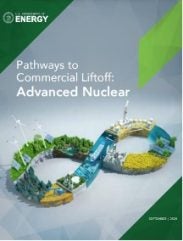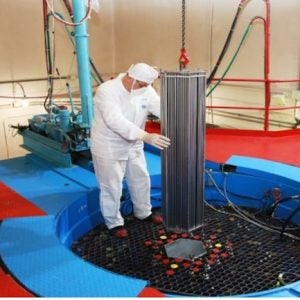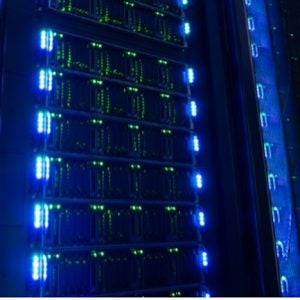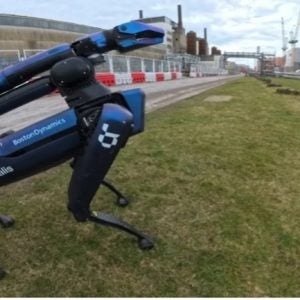
The US Department of Energy (DOE) has issued an updated version of its Pathways to Commercial Liftoff – Advanced Nuclear report. The update reflects unprecedented load growth, renewed interest in AP1000s, and increased recognition of the value of the existing nuclear fleet, including plans to restart closed reactors.
Pathways to Commercial Liftoff is a series of reports launched by the DOE to provide public and private sector capital allocators with a perspective as to how and when various technologies could reach full-scale commercial adoption, including a common analytical fact base and critical signposts for investment decisions. The first four Liftoff Reports on clean hydrogen, advanced nuclear, and long duration energy storage, were published in March 2023.
The Nuclear Liftoff Report was published in March 2023 as a “living document” to be updated as the market evolved. The 80-page updated report, adds new content and refreshes original content.
US nuclear capacity has the potential to triple from some 100 GW in 2024 to around 300 GW by 2050. The original report clarified nuclear’s value proposition and path to large scale deployment. “Since publication, a widespread surge in electricity demand after decades of stasis has increased the need for and interest in nuclear.” Much of this load growth is being driven by artificial intelligence and data centres with a particular need for carbon-free 24/7 generation concentrated in a limited footprint. This provides a set of customers willing and able to support investment in new nuclear generation assets.
“Combined with the Inflation Reduction Act (IRA) incentives, this demand has created a step change in the valuation of the existing fleet and new reactors. In 2022, utilities were shutting down nuclear reactors; in 2024, they are extending reactor operations to 80 years, planning to uprate capacity, and restarting formerly closed reactors.”
Nuclear has an essential role in the energy transition as a clean firm complement to renewables. The US will need at least 700–900 GW of additional clean firm capacity to reach net-zero and nuclear is one of the few proven options that could deliver this at scale. “Nuclear does not “displace” or “compete with” renewables; decarbonisation will require both new nuclear and renewable capacity.”
Nuclear generates carbon-free electricity, provides firm power that complements renewables, has low land-use requirements, and has lower transmission requirements than distributed or site-constrained generation sources. “It also offers high-paying jobs and significant regional economic benefits, can aid in an equitable transition to a net-zero grid, and has a wide variety of use cases that enable grid flexibility and decarbonisation beyond the grid, including high temperatures for industrial heat.”
The report notes that the existing fleet of 94 nuclear reactors at 54 sites provide ~20% of US electricity generation. Investing in subsequent licence renewals is essential. Of the 94 operating US reactors, 84 have licences that will expire prior to 2050; 24 have licences that will expire prior to 2035. Power uprates totalling 2-8 GW could add near-term capacity to existing reactors.
Existing nuclear sites offer significant benefits for siting new nuclear, and preliminary analysis shows there may be room for 60-95 GW of new nuclear at existing sites. Multi-unit plants benefit from economies of scale: generating costs at multi-unit plants are 30% cheaper per MWh than single unit plants.
Advanced nuclear includes a range of proven and innovative technologies across two generations (Gen III+ and Gen IV) and includes three size categories (large, small, and micro). Gen III+ reactors are evolutions of the US operating fleet: they use water as a coolant, use low enriched uranium as fuel, and have passive safety systems. Gen IV reactors will use non-water coolants and fuel that are not currently used by the US fleet and will offer multiple advantages, including expanded use cases such as high temperatureheat for industrial applications. Tripling nuclear capacity by 2050 likely will require both Gen III+ and Gen IV designs.
As to SMRs, although they maybe more expensive than large reactors as measured by $/MW and $/MWh, they offer advantages for certain applications, e.g., replacing smaller retiring coal plants or industrial processes requiring high temperature heat as well as potential siting, construction, and financial advantages.
Microreactors could serve a variety of use cases where reliability, transportability, and compactness are highly valued and alternatives are expensive, e.g., military bases, remote applications including mining, rural communities, industrial operations, and disaster relief.
While first-of-a-kind (FOAK) reactors may be expensive, repeat deployments within a design are expected to drive substantial cost reductions. Eliminating rework, experience, and cross-site standardisationare expected to drive the majority of FOAK to Nth of- a-kind cost reductions. The nuclear industry, working together with customers and offtakers, can accelerate the learning curve by down-selecting and standardising reactor designs, minimizing time between projects, and siting multiple units at the same location.
Delivering the first projects reasonably on-time and on-budget will be essential for achieving liftoff, the report says. The Vogtle NPP “provides essential lessons for project delivery” Completion of units 3&4 made Vogtle the largest clean energy generation site in the US. The cost of Vogtle Units 3 and 4 is not the correct anchor point for estimating additional AP1000s given costs that should not be incurred again. “Vogtle began construction with an incomplete design, an immature supply chain, and an untrained work force; the AP1000 design is now complete, there is now supply chain infrastructure, and Vogtle trained over 30,000 workers.
“The US must develop nuclear and megaproject delivery infrastructure. The integrated project delivery model aligns incentives between owners and contractors to deliver projects on-time and on-budget. Funding constructability research could target the drivers of cost overruns and improve project delivery.”
Industry, investors, government, and the broader stakeholder ecosystem each has a role to play in ensuring new nuclear achieves commercial liftoff and rises to meet the challenge in time.






